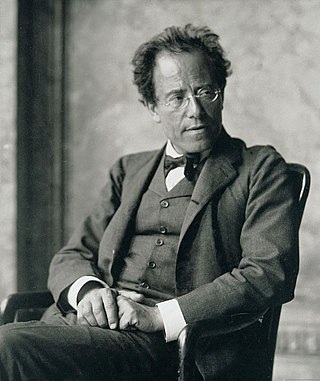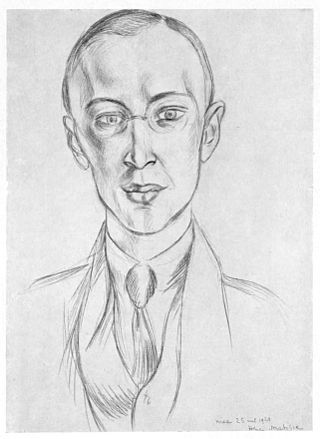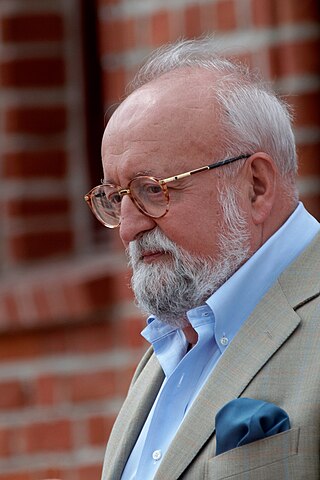Related Research Articles

The Symphony No. 10 in F-sharp major by Gustav Mahler was written in the summer of 1910, and was his final composition. At the time of Mahler's death, the composition was substantially complete in the form of a continuous draft, but not fully elaborated or orchestrated, and thus not performable. Only the first movement is regarded as reasonably complete and performable as Mahler intended. Perhaps as a reflection of the inner turmoil he was undergoing at the time, the 10th Symphony is arguably his most dissonant work.

Ludwig van Beethoven's Piano Sonata No. 29 in B♭ major, Op. 106 is a piano sonata that is widely viewed as one of the most important works of the composer's third period and among the greatest piano sonatas of all time. Completed in 1818, it is often considered to be Beethoven's most technically challenging piano composition and one of the most demanding solo works in the classical piano repertoire. The first documented public performance was in 1836 by Franz Liszt in the Salle Erard in Paris.

Sergei Prokofiev wrote his Symphony No. 2 in D minor, Op. 40, in Paris in 1924-25, during what he called "nine months of frenzied toil". He characterized this symphony as a work of "iron and steel".

Sergei Prokofiev wrote his Symphony No. 3 in C minor, Op. 44, in 1928.
Cyclic form is a technique of musical construction, involving multiple sections or movements, in which a theme, melody, or thematic material occurs in more than one movement as a unifying device. Sometimes a theme may occur at the beginning and end ; other times a theme occurs in a different guise in every part.

Nikolai Yakovlevich Myaskovsky or Miaskovsky or Miaskowsky, was a Russian and Soviet composer. He is sometimes referred to as the "Father of the Soviet Symphony". Myaskovsky was awarded the Stalin Prize five times.

Franz Schubert's Symphony No. 8 in B minor, D. 759, commonly known as the Unfinished Symphony, is a musical composition that Schubert started in 1822 but left with only two movements—though he lived for another six years. A scherzo, nearly completed in piano score but with only two pages orchestrated, also survives.

The Symphony No. 5 in E minor, Op. 64 by Pyotr Ilyich Tchaikovsky was composed between May and August 1888 and was first performed in Saint Petersburg at the Mariinsky Theatre on November 17 of that year with Tchaikovsky conducting. It is dedicated to Theodor Avé-Lallemant.

Anton Bruckner's Symphony No. 3 in D minor, WAB 103, was dedicated to Richard Wagner and is sometimes known as his "Wagner Symphony". It was written in 1873, revised in 1877 and again in 1889.

The Symphony No. 5 in E-flat major, Op. 82, by Jean Sibelius is a symphony in three movements.
Dmitri Shostakovich's String Quartet No. 11 in F minor, Op. 122 was finished on January 30, 1966, in Moscow. It was premiered by the Beethoven Quartet and is the first in a series of four quartets to be dedicated to members of the Quartet. Vasily Shirinsky was the dedicatee of the Eleventh, the quartet's second violinist, who died on August 16 of the previous year.
Visions fugitives, Op. 22, is a cycle of twenty piano miniatures by Sergei Prokofiev. The seventh piece was also published for harp. They were written between 1915 and 1917, individually, many for specific friends of the composer, and premiered by him as a cycle lasting some twenty minutes on April 15, 1918, in Petrograd. Gutheil published both the piano set and the one piece for harp in 1917 in Moscow.
The Symphony No. 6 in E-flat minor, Op. 23 by Nikolai Myaskovsky was composed between 1921 and 1923. It is the largest and most ambitious of his 27 symphonies, and uses a chorus in the finale. It has been described as "probably the most significant Russian symphony between Tchaikovsky's Pathétique and the Fourth Symphony of Shostakovich". The premiere took place at the Bolshoi Theatre, Moscow on 4 May 1924, conducted by Nikolai Golovanov and was a notable success.

The Piano Quartet No. 3 in C minor, Op. 60, completed by Johannes Brahms in 1875, is scored for piano, violin, viola and cello. It is sometimes called the Werther Quartet after Goethe's The Sorrows of Young Werther. The premiere took place in Vienna on November 18th 1875 to an anxious public. Richard Wagner and his wife Cosima were in attendance.

The Symphony No. 3 is a symphony in five movements composed between 1988 and 1995 by Krzysztof Penderecki. It was commissioned and completed for the centenary of the Munich Philharmonic. Its earliest version, Passacaglia and Rondo, premiered at the International Music Festival Week in Lucerne, Switzerland, on August 20, 1988. It was performed by the Lucerne Festival Orchestra and conducted by Penderecki. The full symphony premiered in Munich on 8 December 1995, performed by the Munich Philharmonic, again conducted by the composer.
Nikolai Myaskovsky wrote his Symphony No. 3 in A minor, Op. 15 in 1914.
The Symphony No. 1 in C minor, Op. 3, by Nikolai Myaskovsky was written in 1908.

Schubert's Symphony in D major, D 708A, is an unfinished work that survives in an incomplete eleven-page sketch written for piano solo. It is one of Schubert's six unfinished symphonies. It was begun in 1820 or 1821, with initial sketches made for the opening sections of the first, second, and fourth movements, and an almost complete sketch for the third movement. He abandoned this symphony after this initial phase of work and never returned to it, although Schubert would live for another seven years. British conductor and composer Brian Newbould, an authority on Schubert's music, has speculated that the symphony was left incomplete due to problems Schubert faced in orchestrating the sketch.
Aaron Copland wrote the Symphony for Organ and Orchestra in 1924. It represents a major work in the composer's oeuvre, as it was his first fully realized orchestral work, his first work for organ, and the first piece whose orchestration he heard. It was premiered on January 11, 1925, in New York. In 1928, Copland re-orchestrated the work without organ as his Symphony No. 1, rewriting the organ part in the brass and adding saxophone.
Nikolai Myaskovsky's Symphony No. 5 in D Major, Op. 18, was written in 1918. It was premiered on 18 August 1920 by the conductor Nikolai Malko.
References
- ↑ Gulinskaya, Nikolai Jakowlewitsch Mjaskowski. Moskau 1981, German edition Berlin 1985.